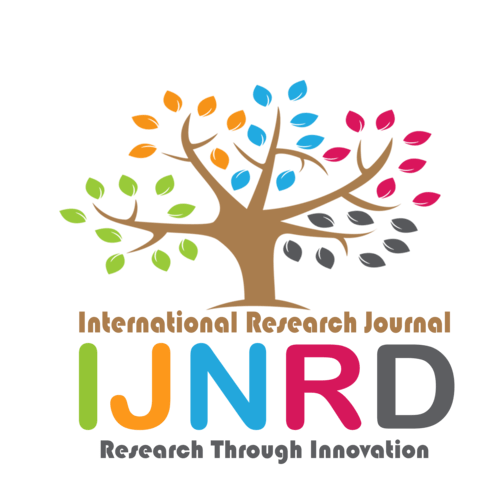|
|||||||||||||||

|
INTERNATIONAL JOURNAL OF NOVEL RESEARCH AND DEVELOPMENT International Peer Reviewed & Refereed Journals, Open Access Journal ISSN Approved Journal No: 2456-4184 | Impact factor: 8.76 | ESTD Year: 2016 Scholarly open access journals, Peer-reviewed, and Refereed Journals, Impact factor 8.76 (Calculate by google scholar and Semantic Scholar | AI-Powered Research Tool) , Multidisciplinary, Monthly, Indexing in all major database & Metadata, Citation Generator, Digital Object Identifier(DOI) |
||||||||||||||
Issue: April 2024
Volume 9 | Issue 4
Review Result and Publication of Paper within : 2-3 days
Click Here For more DetailsFor Authors
Forms / Download
Published Issue Details
Editorial Board
Other IMP Links
Facts & Figure
Impact Factor : 8.76
Issue per Year : 12
Volume Published : 9
Issue Published : 95
Article Submitted :
Article Published :
Total Authors :
Total Reviewer :
Total Countries :
Indexing Partner
Join RMS/Earn 300
Licence
This work is licensed under a Creative Commons Attribution-NonCommercial 4.0 International License







|
Published Paper Details
|
|
| Paper Title: | Moringa oleifera: A Review Article on its Nutritional Properties and Prospects in Nepal |
| Authors Name: | pachorkar Gayatri balasaheb , Lade harish ravsaheb , Gayatri shashikant Dhakane , Sayali Jagdish Chothave |
| Download E-Certificate: | Download |
| Author Reg. ID: |
IJNRD_186022
|
| Published Paper Id: | IJNRD2301147 |
| Published In: | Volume 8 Issue 1, January-2023 |
| DOI: | |
| Abstract: | Moringa oleifera is an Angiospermic plant often known as the 'drumstick' or 'horseradish' tree. It is a member of the Moringa genus, which has 13 distinct species. Among these, Moringa oleifera is the most frequently grown species endemic to the tropical and subtropical regions of the world [1]. Moringa oleifera is a tropical deciduous perennial dicotyledonous tree. It is known by several names in different places, including "Shiferaw" in Ethiopia, drumstick tree or horseradish tree in India, and 'Sitalchini', Munga, Sahijan or Saijan in Nepal. It is a petite, elegant, deciduous tree with scant leaves of the Moringaceae family. The tree is 5 to 10 metres tall [2]. The leaves are alternating, the old ones fall off quickly, and each leaf can grow to be up to 90 cm long, with opposing petals. pinnae. They are 5cm apart from the plant's centre stalk. Moringa has somewhat bigger terminal leaflets that are arranged in opposing pairs. Leaflets are dark green on top and pale on the bottom, and they vary in size and form, although they are usually rounded-elliptic and up to 2.5 cm long. Throughout the year, flowers appear in loose axillary panicles up to 15cm long. Fruits are huge and unusual, up to 90 cm long and 12 mm wide, somewhat constricted at intervals, gradually tapering to a tip, 3- (4-) angled, and with two grooves on each face. They are also light brown in colour. It separates along each angle to disclose the rows of spherical blackish oily seeds, each with three papery wings [3]. The forests form forks from the base region. Smooth, dark grey slash thin, and yellowish bark. The tree's twigs and shoots are short and dedensely-hairedThe Crown is composed of a single stem that is large, open, and often umbrella like. The tree has deep roots and soft wood [3]. Moringa oleifera is a bisexual plant that is extensively cross-pollinated due to heteromorphism. Carpenter bees (Xylocopalatipes and X. pubescens) have been identified as the most dependable and suitable pollinators for Moringa. The main goal of this review was to highlight the nutritional, medicinal, and commercial properties of Moringa, to learn about the potential of Moringa cultivation in Nepal, to suggest future directions for research, market, and development strategies, and to evaluate a published scientific journal article on Moringa oleifera's multipurpose use. |
| Keywords: | activity |
| Cite Article: | "Moringa oleifera: A Review Article on its Nutritional Properties and Prospects in Nepal", International Journal of Novel Research and Development (www.ijnrd.org), ISSN:2456-4184, Vol.8, Issue 1, page no.b400-b410, January-2023, Available :http://www.ijnrd.org/papers/IJNRD2301147.pdf |
| Downloads: | 000118750 |
| ISSN: |
2456-4184 | IMPACT FACTOR: 8.76 Calculated By Google Scholar| ESTD YEAR: 2016 An International Scholarly Open Access Journal, Peer-Reviewed, Refereed Journal Impact Factor 8.76 Calculate by Google Scholar and Semantic Scholar | AI-Powered Research Tool, Multidisciplinary, Monthly, Multilanguage Journal Indexing in All Major Database & Metadata, Citation Generator |
| Publication Details: |
Published Paper ID:IJNRD2301147 Registration ID: 186022 Published In: Volume 8 Issue 1, January-2023 DOI (Digital Object Identifier): Page No: b400-b410 Country: nashik, maharashtra, India Research Area: Pharmacy Publisher : IJ Publication Published Paper URL : https://www.ijnrd.org/viewpaperforall?paper=IJNRD2301147 Published Paper PDF: https://www.ijnrd.org/papers/IJNRD2301147 |
| Share Article: | |
|
Click Here to Download This Article |
|
| Article Preview | |
|
|
|
Major Indexing from www.ijnrd.org
| Semantic Scholar | Microsaoft Academic | ORCID | Zenodo |
| Google Scholar | ResearcherID Thomson Reuters | Mendeley : reference manager | Academia.edu |
| arXiv.org : cornell university library | Research Gate | CiteSeerX | PUBLON |
| DRJI | SSRN | Scribd | DocStoc |
ISSN Details
 |
 |
ISSN: 2456-4184
Impact Factor: 8.76 and ISSN APPROVED
Journal Starting Year (ESTD) : 2016
DOI (A digital object identifier)
Conference
Open Access License Policy
Important Details
Social Media
| Copyright © 2024 - All Rights Reserved - IJNRD |












Facebook Twitter Instagram LinkedIn